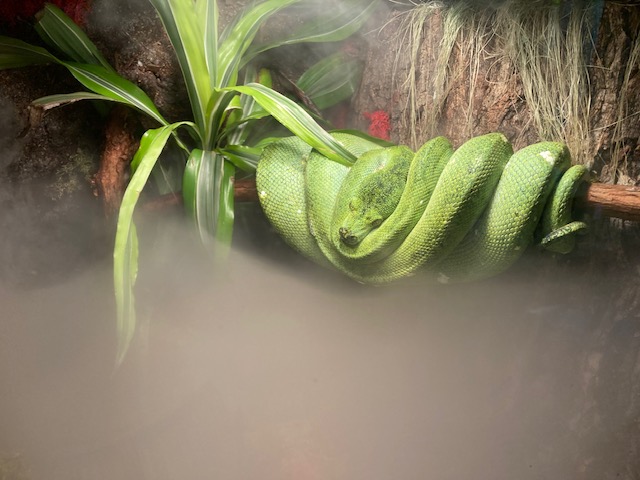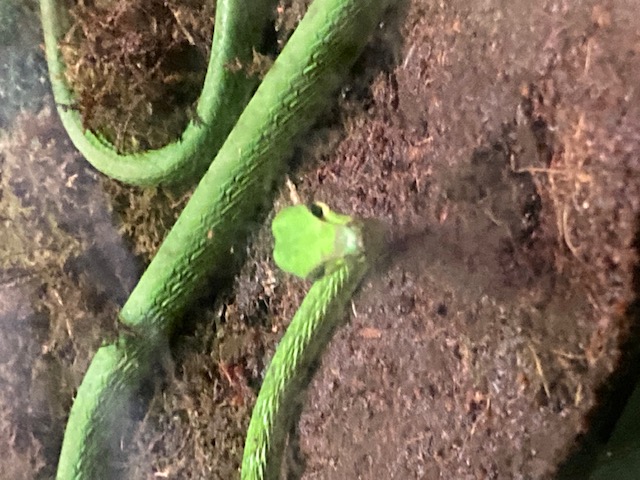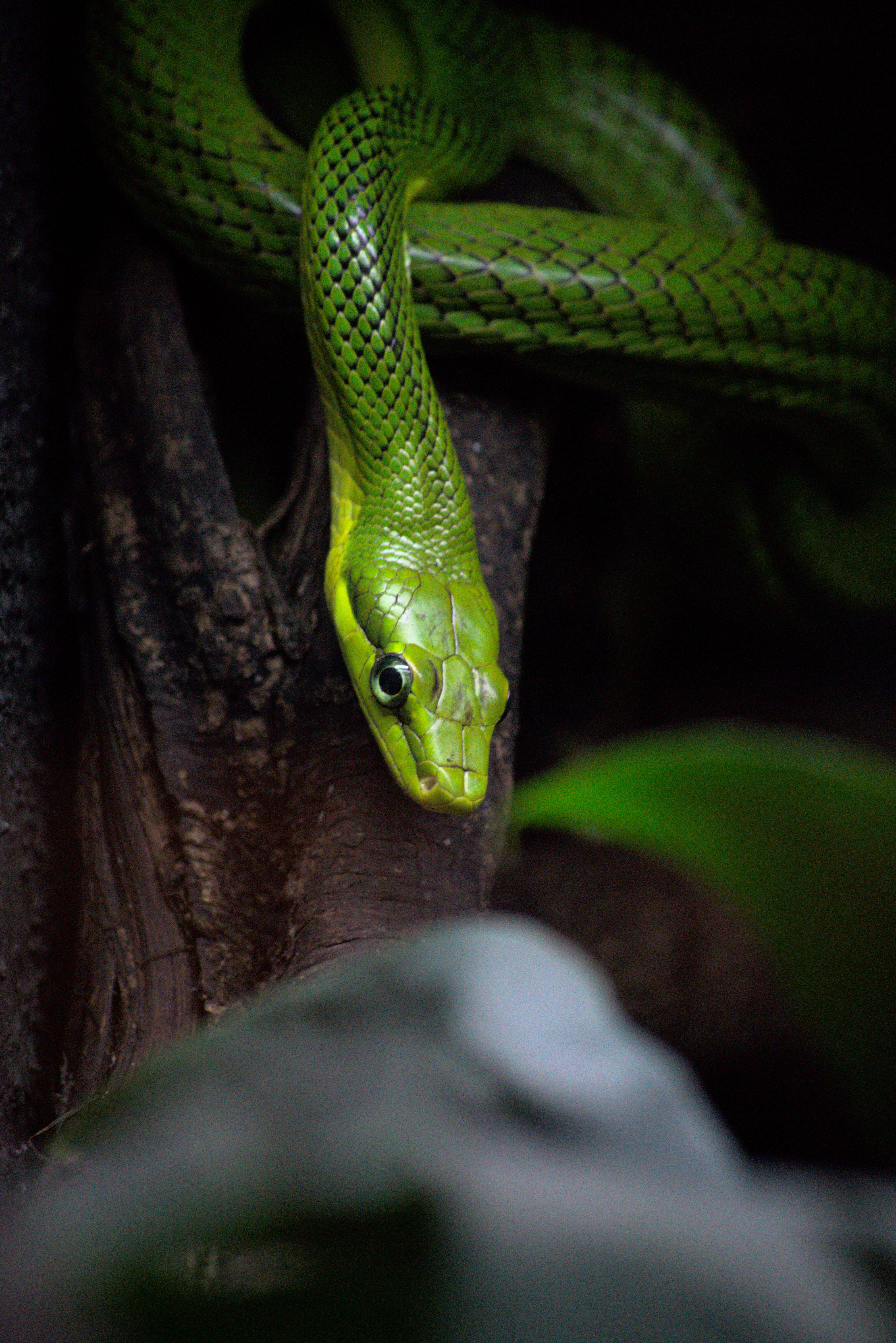Dream Eater
A Snake out of Nightmares
As seen in
Upon a second study, it is clear this is a different species, as they constrict their prey, rather than using venom. Though it does appear to secrete a mild poison along its skin, rather than in its fangs.
Description
Dream eaters usually reach 4-6 feet in length, and weigh around 2 pounds. Hatchlings are usually about 1 foot in length. They are typically vivid green in color, which likely helps them camouflage in trees. They are non-venomous, though they will use their fangs as an initial strike to catch their prey. When hunting, they also secrete a nuerotoxin along their skin, which they use to sedate prey. Instead of actively hunting, the dream eater will sometimes hide itself amidst foliage and wait for unsuspecting prey to stumble upon it. Dream eaters also use this prey to subdue larger animals, including birds of prey.
Habitat
So far, dream eaters have only been found in the mountainous and forested areas near Yuenpol. Scientists believe this is because they prefer damp, foggy areas. Fantastic climbers, dream eaters likely use both fog and foliage to camouflage themselves while hunting for prey, usually rodents and bird eggs. Dream eaters have been known also to eat parent birds alongside eggs, later using the nests for their own eggs, which has unfortunately made them popular pets among Xurugwi families, greatly reducing their numbers in the wild since their discovery in 1751.
Discovery
Originally believed to be part of another snake species, the dream eaters were discovered in 1751 by Dultana Petropik, a Suraci scientist trying to learn to communicate with animals magically. While camping long-term in the Yuenpol Forest, she observed the snakes, noting their habit of constricting, rather than poisoning their victims, like other snakes in the area. She also discovered that they are larger than other local snakes, and attributed the previous misclassification to the fact that they spend a great deal of time in trees, and can disguise their size when wrapped around a branch. Petrovic was also the first to discover the toxic secretions the snake made, describing vivid hallucinations after coming into physical contact with the substance.
Myth
Dream eaters get their name from a Calistian myth in which a group of nightmares escape the realm of dreams, and the Calistian god Bella sends a large snake to swallow them before they terrorize the mortal realms. Bella herself must eventually pursue the snake when it begins to eat not only nightmares, but pleasant dreams as well. It is likely the toxic secretions, which have been found to have hallucinogenic effects, have also contributed to their name.
Since the discovery of the dream eater's prevalence in the Yuenpol Forest, most Suraci now believe that this forest is a gateway to the realm of Bella, the god of dreams, and the broader Calistian world. This has actually made them advocates for the snake and the larger wildlife area. Suraci have been known to speak out against the breeding of dream eaters, which is often done by Xurugwi as pets to keep tricksters at bay, and sometimes by others who use the snake's secretions to make hallucinogenic drugs. Though the numbers of dream eaters in the wild dropped greatly in the first centuries after their discovery, Suraci activism has led to strict laws against taking the snakes from the wild and their numbers have risen again in the last hundred years.
So far, dream eaters have only been found in the mountainous and forested areas near Yuenpol. Scientists believe this is because they prefer damp, foggy areas. Fantastic climbers, dream eaters likely use both fog and foliage to camouflage themselves while hunting for prey, usually rodents and bird eggs. Dream eaters have been known also to eat parent birds alongside eggs, later using the nests for their own eggs, which has unfortunately made them popular pets among Xurugwi families, greatly reducing their numbers in the wild since their discovery in 1751.
Discovery
Originally believed to be part of another snake species, the dream eaters were discovered in 1751 by Dultana Petropik, a Suraci scientist trying to learn to communicate with animals magically. While camping long-term in the Yuenpol Forest, she observed the snakes, noting their habit of constricting, rather than poisoning their victims, like other snakes in the area. She also discovered that they are larger than other local snakes, and attributed the previous misclassification to the fact that they spend a great deal of time in trees, and can disguise their size when wrapped around a branch. Petrovic was also the first to discover the toxic secretions the snake made, describing vivid hallucinations after coming into physical contact with the substance.
Myth
Dream eaters get their name from a Calistian myth in which a group of nightmares escape the realm of dreams, and the Calistian god Bella sends a large snake to swallow them before they terrorize the mortal realms. Bella herself must eventually pursue the snake when it begins to eat not only nightmares, but pleasant dreams as well. It is likely the toxic secretions, which have been found to have hallucinogenic effects, have also contributed to their name.
Since the discovery of the dream eater's prevalence in the Yuenpol Forest, most Suraci now believe that this forest is a gateway to the realm of Bella, the god of dreams, and the broader Calistian world. This has actually made them advocates for the snake and the larger wildlife area. Suraci have been known to speak out against the breeding of dream eaters, which is often done by Xurugwi as pets to keep tricksters at bay, and sometimes by others who use the snake's secretions to make hallucinogenic drugs. Though the numbers of dream eaters in the wild dropped greatly in the first centuries after their discovery, Suraci activism has led to strict laws against taking the snakes from the wild and their numbers have risen again in the last hundred years.
Dream eaters get their name from a Calistian myth in which a group of nightmares escape the realm of dreams, and the Calistian god Bella sends a large snake to swallow them before they terrorize the mortal realms. Bella herself must eventually pursue the snake when it begins to eat not only nightmares, but pleasant dreams as well. It is likely the toxic secretions, which have been found to have hallucinogenic effects, have also contributed to their name.
Since the discovery of the dream eater's prevalence in the Yuenpol Forest, most Suraci now believe that this forest is a gateway to the realm of Bella, the god of dreams, and the broader Calistian world. This has actually made them advocates for the snake and the larger wildlife area. Suraci have been known to speak out against the breeding of dream eaters, which is often done by Xurugwi as pets to keep tricksters at bay, and sometimes by others who use the snake's secretions to make hallucinogenic drugs. Though the numbers of dream eaters in the wild dropped greatly in the first centuries after their discovery, Suraci activism has led to strict laws against taking the snakes from the wild and their numbers have risen again in the last hundred years.





I quite like how you approached this, it feels very grounded— not only in how it was discovered, but in how it was named! Makes it feel very human, in a sense, how your world classified and dealt with them!
Thanks!